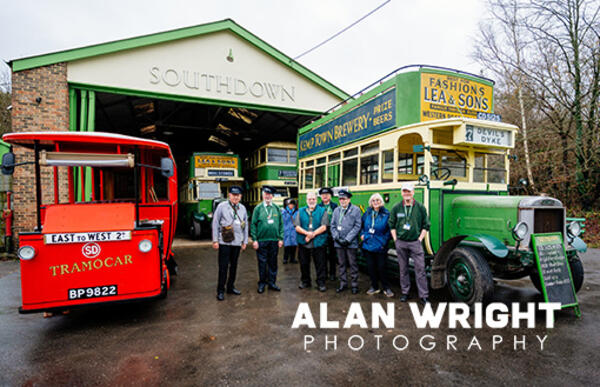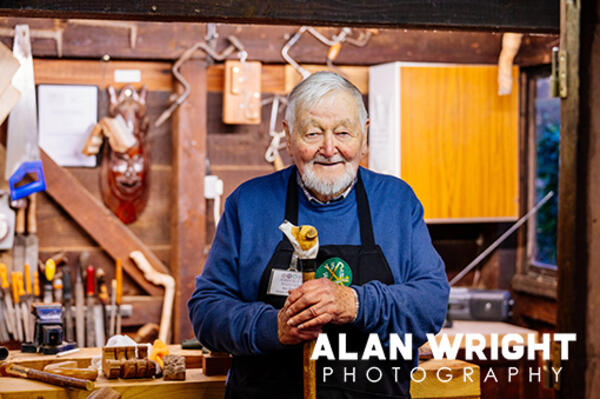PRINCESS ROYAL VISTS AMBERLEY

Published on 1st January 2025
Her Royal Highness The Princess Royal officially opened the newly-restored Bagging Shed and Loading Bay at Amberley Museum on Thursday 5 December 2024.
Having met volunteers at Shoreham’s National Coastwatch Initiative and toured the Rolls-Royce plant at Goodwood in the morning, Her Royal Highness spent the afternoon at the industrial heritage museum in the heart of the South Downs. She was greeted by Museum Director Katrina Burton, Chair of Trustees Surrie Everett-Pascoe and dignitaries including the Lord Lieutenant of West Sussex Lady Emma Barnard and HDC Chairman Nigel Emery. Touring the site on foot, the Princess also met some of the museum’s dedicated volunteers and during a speech congratulated them for collectively receiving the King’s Award for Voluntary Service.
The museum, founded in 1978, is built on the site of a former industrial quarry, where for more than a century chalk was extracted for lime. Many of the museum’s attractions focus on transport, including an important collection of narrow-gauge railway equipment, locomotives and rolling stock. Many of the locomotives have been restored to working order by the volunteers and run along sections of railway that provide transport for visitors around the site.
While the Princess Royal didn’t board a locomotive, she took the time to admire one of the museum’s steam rollers, while volunteer Gerry Cork operated a Hudson Hunslet diesel locomotive on part of the track, near the closed entrance of the old quarry tunnel, which was used for filming dramatic scenes in the 1985 James Bond film, A View to a Kill.
Gerry said: ‘I’m in my 38th season as a volunteer at Amberley, working with various locomotives at the museum. During the Royal visit, I operated the Hudson Hunslet, which was manufactured in the 1940s. It’s one of several engines in our collection that was once used at local brickworks, such as Warnham. Most were built for narrow-gauge railway lines, but there was no narrow gauge when the chalk pits were open. It instead used standard gauge and the line ran from a siding close to where Amberley Station is today, along what is now the path to the museum entrance and down to the de Watt kilns.’
‘We do have one standard-gauge locomotive that is similar to the industrial engines once used at the chalk pits, which continues to generate interest from James Bond fans. In the film, you see them enter the tunnel and Grace Jones’ character (May Day) is killed in an explosion outside the pit. Two locomotives and some of our tipper wagons can be seen in the film. They were all painted with the logo of Zorin Industries for filming and we still have one engine with the logo!’

The Princess Royal walked around the Witt Kilns, which once homed 18 firing chambers, when the site employed over 80 people and reverberated to the noise of explosions, furnace blasts and rumbling trucks, trains and horses. From the 1840s to the 1960s, chalk was quarried here, then heated in kilns with coal to create quicklime. Water was then added to create hydrated lime, which could be sold as a source material for fertiliser, mortar, cement and concrete.
She then met volunteers at the Wheelwright’s shop (which originally stood at 54 London Road in Horsham) then the team at Southdown Bus Garage. The garage is among the most popular exhibits, as it invokes memories of the yellow and green livery of the Southdown Motor Services, which once operated across Sussex and Hampshire. She also took the time to meet volunteers next door at the village garage and cycle shop, which dates back to the late 1920s. Nick Strain has volunteered at Amberley for four years after spending a long career developing air traffic control systems. He can often be seen riding around the site on the shop’s trade bicycle.
Nick said: ‘In 2021, when the museum re-opened after Covid, I decided to volunteer in the garage. I have a 1940 Ford truck and love tinkering with classic vehicles, but I especially love the repair shop as everyone has their own bicycle story. What is great about the shop is that it really existed, with Mr Floyd running his successful cycling shop and repair business in Littlehampton. We are sometimes visited by his relatives or former staff members and customers, and when they see Mr Floyd’s old counter and tools, it takes them on a nostalgic journey. When you’re working with these tools, you can feel the history they carry too.’
‘I often ride the trade bike around the museum, always wearing a helmet and goggles, as it’s important to set a good example to younger visitors. We welcome a lot of school trips as there’s an important educational aspect to our role. As well as the repair shop, the museum has a collection of bicycles spanning 190 years, so children can learn about the evolution and history of cycling.’

The Princess Royal also visited the Arundel gin building, where the Worshipful Company of Plumbers demonstrate their craft, before being presented with a walking stick hand-made by craftsman Ken Wood. Ken is a member of Saxon Stickmakers and has been based at the museum for 15 years. The stick-making workshop is one of several craft attractions at Amberley, with wood-turners, a blacksmith, cobbler, ironmongers, potters and broom-makers also on-site. Ken shares a workshop with another stick-maker so that it can open to the public four days a week. He often polishes and finishes sticks that he has cut and crafted at his home in Ashington.
Ken told AAH: ‘I usually use chestnut for the shanks, as it’s a hardy wood and areas are coppiced around the South Downs. The cuttings I require are too thin for timber yards, but they’re perfect for my trade. I was very proud to make a stick for The Princess Royal. The museum team asked me to carve a horse’s head for the handle, which I’d never done before, although I have carved dogs and several birds. A horse’s head is quite large, but I wanted to make it small to ensure the stick remained comfortable and functional. I shaped the shank from hazel, but the handle is made from walnut, finished with a silver collar. I was still working on it the night before the Princess’s visit as I wanted it to be just right. She looked pleased with it. I did ask if she needed it cut to size, but it seemed a good fit!’
Before departing, Her Royal Highness visited the restored Bagging Shed and Loading Bay, located near the museum entrance. This late-19th century building was once at the heart of the bustling chalk pit and has been restored thanks to a grant from the DCMS Museum Estate and Development fund, administered by the Arts Council. Before leaving, she also unveiled a plaque during a short outdoor ceremony attended by museum volunteers and invited guests. In the speech, she praised the dedication of the volunteers for the transformation of the Bagging Shed, then joked she was sure that – rather than resting on their laurels – the volunteers would soon find something else that needed doing!
The volunteers hope that the Royal visit will inspire others to explore the museum, with exhibitions covering everything from vintage vehicles to electrical goods. Gerry Cork said: ‘It’s great to have something like this happen as it gives us positive publicity. We are getting better at publicising our attractions and events such as steam rallies and vintage bus shows, but for a long time Amberley Museum was called “the best kept secret in Sussex.” Ideally, we’d like it to be less of a secret, so that we can share our passion with more people.’
WORDS: Ben Morris / PHOTOS: Alan Wright
Further information: Visit the website to find out more about opening dates, ticket prices and special events visit www.amberleymuseum.co.uk


